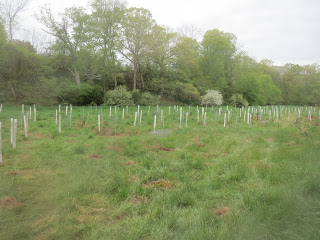Chambers Brook Tree Planting
Let's do something a little different today; I'm going to talk about a tree-planting activity organized by Raritan Headwaters Association.
The last 3 days I've been planting native trees and shrubs in a field adjacent to Chambers Brook in Readington Township. My impression is that this land is owned by the township. (We needed to gain access through the cooperation of a Christmas tree farm though there are plans for public access in the future. You probably shouldn't rush out there to check on my work.)
The field used to be grazed by cows, probably before Readington owned the property. Though you can't tell it from this picture, the field is quite muddy and frequently quite lumpy.
Although humans can't currently access this field without either trespassing or bushwhacking, the central New Jersey deer population can easily get here. To prevent deer from devouring the plantings, each plant gets its individual protection. Trees, expected to grow straight up, get the plastic sleeves you can easily see in the picture above. Shrubs, on the other hand, are expected to spread wide, and they get wire cages. Technically deer can probably browse some leaves that should eventually poke out of the cage, this is presumably considered minor damage that won't kill the shrubs. It's quite a bit harder to see those metal cages, but you'll see some of them if you look closely.
Almost all the holes were dug before we got here using some mechanical auger. This did save some time, though not as much as I expected since:
- The holes were much wider and deeper than needed, so a fair amount of time was spent putting the correct amount of dirt back in the holes.
- The ground was fairly soft, not very rocky, and it wasn't very hard to dig the 1 hole I needed to dig. (There were issues in getting the auger into some spots, which was probably the only reason some holes weren't pre-dug.





Comments
Post a Comment